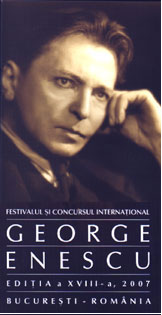|
George
Enescu (1881-1955) (also Georges Enesco, in French) |
|||
|
|
|||
|
The Romanian composer George Enescu is one of the neglected giants of modern music. Prodigiously gifted, he became best known in America as a conductor (where he was considered as a successor to Toscanini in New York) and in Europe as one of the greatest violinists of the century. But he was first and foremost a composer; and, tragically, his mature works - works of extraordinary emotional depth and intricate beauty - remain virtually unknown outside Romania. George Enescu was said by Pablo Casals to be "the most amazing musician since Mozart", a statement which in many respects was true. He achieved international renown as a composer, violinist, pianist, conductor and teacher and he displayed genius in each of these disciplines. He possessed a phenomenal memory and knew the entire repertoire of classical and romantic music by heart, in addition to many works of the twentieth century, with which one of his generations might well have been though unsympathetic. Apart from these superlative gifts, Enescu was a man of humility; he was a profound teacher (counting Yehudi Menuhin and Dinu Lipatti amongst his pupils) who impressed every musician who met him. He was born in 19 August 1881 in Liveni, Romania. So gifted was he that, aged only seven, he entered the Vienna Conservatoire as an accomplished violinist, determined to be a composer. Enescu never forgot his home, set amidst Carpathian peaks, and graduated with distinction from Conservatoire before his 11th birthday. He had played on the first desk of an orchestra under Brahms in the latter's C minor Symphony and accompanying Brahms in his First Piano Concerto. Brahms was a lifelong hero, as was Wagner (indicating Enescu's broad sympathies) who became, as he sad, "part of my vascular system". Enescu was at the Vienna premiere of Massenet's Werther in 1892 and he entered the Paris Conservatoire, studying composition with Massenet. When the boy was only 13, Massenet wrote to Enescu's father, "Your son is an exceptional individual; his is the most interesting musical constitution there can be". Enescu displayed a command of large-scale form: by the age of 16 he had written four Study Symphonies and had also given the premiere of his Violin Concerto in Paris in 1886. Amongst a distinguished orchestral output, Enescu left eleven symphonic works: four Study Symphonies written between 1895-1898 and five mature symphonies (the Fourth and Fifth are unfinished) plus a Concert Symphony for cello and orchestra and a Chamber Symphony. He often lived in Paris, travelling widely, but returned to Romania for several lengthy periods, remaining there throughout World War II. After died in 4 May 1955, his hometown of Liveni was renamed George Enescu. |
|||
|
|
|||
|
This page was last updated on 10/08/2007 Many thanks to Ionut Naulea for his help |
|||

